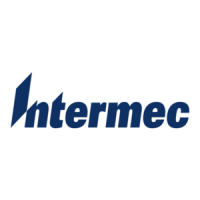TRAKKER Antares 2420 and 2425 Hand-Held Terminal User’s Manual
Co de 39
Nugget
4-36
About Network Connectivity and Protocols
The T2420 and T2425 are hand-held data collection terminals with network support. The
terminals communicate with a host computer or other serial device through the terminal’s
RS-232 serial port. The T2425 also communicates with a host either through the
DCS 300 or directly through the access points. The access point acts as a bridge between
the Ethernet or token ring network and the RF network.
In a UDP Plus network, the terminal communicates through the DCS 300 to a host on an
Ethernet, token ring, twinaxial, coaxial, or SDLC network. In a TCP/IP network, the
terminal communicates through the access point to the host on an Ethernet or token ring
network.
The communications protocol stack for the terminal is developed using the Open Systems
Interconnection (OSI) seven layer model. The illustration on the next page shows how the
2.4 GHz RF network and RS-232 serial port map into the OSI model.
The terminal applications including terminal emulation and screen mapping are on top of
the protocol stack. Intermec provides a terminal communications API (application
program interface) to interface to the protocol stack. The API provides a common
interface to these Intermec value-added protocols:
• Terminal Message Format (TMF) is an Intermec proprietary protocol that is used to
route data and network management messages between applications on the terminal
and peer tasks on the DCS 300 or host.
• UDP Plus is an Intermec protocol built on top of the User Datagram Protocol (UDP).
It maximizes the performance of wireless (RF) and hardwired networks and provides
robust data communications.
• Trivial File Transfer Protocol (TFTP) allows efficient file exchange between the
terminal and the DCS 300 or host.
• Configurable Serial Port (CSP) protocol allows efficient file exchange between the
terminal and the host through RS-232 serial communications. The terminal uses
either the
XMODEM
or the
YMODEM
protocol to transfer files via reader commands.
• Network management provides network access to the terminal configuration, status,
and statistics. Network management uses the Terminal Message Format to receive
and send messages.
The remaining layers in the protocol stack are a series of standard protocols that interface
with the drivers and hardware needed to support the 2.4 GHz RF network and RS-232
serial communications.

